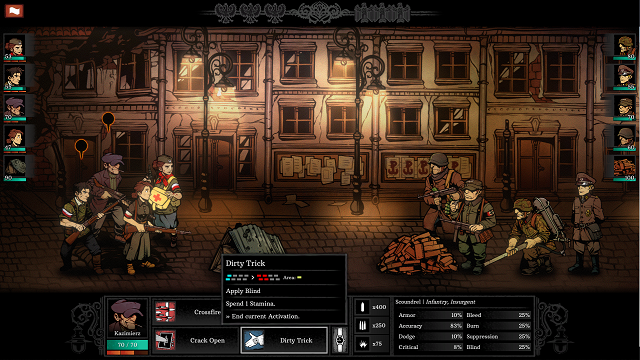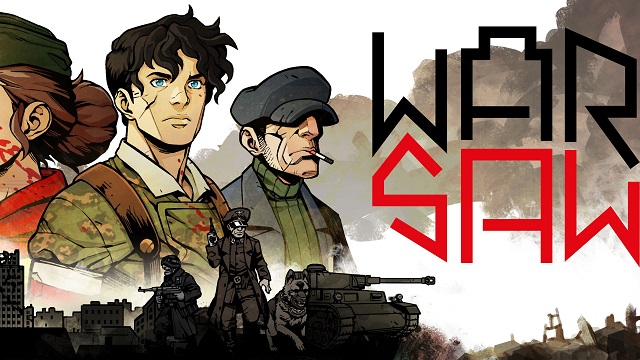If you squint at screenshots of Warsaw, it would be understandable if you thought you were looking at Darkest Dungeon. If you squinted at footage of Warsaw, you might still think you were looking at Red Hook Studios’ bleak RPG. Warsaw‘s animation and art design draw heavy inspiration from Darkest Dungeon. Much of the gameplay does, as well.
In that vein, Warsaw tries to use the bleakness and desperation of Darkest Dungeon to tell a real story about one of the darkest settings the world has ever known: eastern Europe during World War II.
In that regard, Warsaw works well. It has its ups and downs, but it stands as a tough-as-nails RPG with a nice, non-fiction bent. Its central issue is that it just isn’t as good as the games it emulates.
One Thing Only: Killing Nazis

Warsaw is set in Poland during the Warsaw Uprising of 1944. Part of the Polish underground resistance, you must carefully manage your troops and resources, pick the missions you wish to carry out, and try to lead your ragtag army against a nigh-unstoppable German war machine.
Gameplay is broken down into a few different elements. In your headquarters between missions, you have a variety of specialists and shops capable of helping you better your efforts. Leave wounded fighters in the care of the doctor between missions to heal their injuries, recruit new soldiers, purchase better weapons — these are the moment-to-moment activities you’ll carry out.
It would be nice if the different areas of your HQ had a bit more personality. While each character looks unique and full of personality, they’re ultimately nothing more than storefronts, placards devoid of real nuance. In a game that wants to make you feel the true cost of war, this seemingly slight stumble is all the more glaring.
Going out on missions is where you’ll spend most of your time, though. Here, you navigate a map, scrap with German troops, and try to achieve your given objective before you exhaust your team. Your objective might be to kill a certain number of enemies, find some needed supplies, or a myriad of other tasks.
Regardless, missions will always lead to plenty of battles and some tough decisions.
Guerrilla Warfare

As you move through the streets during Warsaw‘s missions, you’re directed to a variety of interest points. Some of these are battles (more on those in a minute), some are supply drops, and some are story beats, the latter of which are laden with decisions that can affect your team in many different ways. Having a certain class or weapon in your loadout, for example, might change the options you have to choose from.
Most of the time, though, you’re losing more than you’re gaining.
Warsaw goes to great lengths to show you how difficult war is, especially if you’re fighting against a massively overpowered foe. Just like Darkest Dungeon, enemies are better equipped and much more numerous than your scant troops. That means you have to be very smart about how to approach situations, and you should only take risks if you’ve gotten to the point of desperation.
Likewise, you will often feel like the underdog when you enter battles with enemy forces. Battles are turn-based, with each side having as many actions as they have troops still alive.
You can move your troops behind cover, inflict status effects on enemies, and deal direct damage directly. You pick your available actions from your equipped weapons, rather than your troops’ classes. Though classes affect your stats, meaning certain troops are better at fitting into certain roles, most any troop can fill any role if you’re desperate.
You can also use the same unit as many times as they have stamina points (most actions will use up a stamina point, which recover slowly), meaning you can get by with one main damage dealer and a support team, provided you keep them alive.
That twist on battles seems like it would open up tactics, but it never really clicked for me.
Some battles devolve into neverending stalemates; I found myself down to a few troops, alternating between minimal damage to enemies behind cover and keeping my last damage dealer alive. All the while, I watched my ammunition grow scarcer as I dealt ineffectual damage.
It felt real, yes; actual skirmishes can often turn into a “whoever has more supplies, wins” exchange. It also just… wasn’t fun. There isn’t much in gaming that’s more disappointing than a neverending turn-based battle.
Into the Dungeon

As you get further into Warsaw, your supplies dwindle faster and your enemies get stronger. Considering the real-world events the game is based on, that impotent feeling of helplessness sets in. It’s extremely difficult to succeed in this game, and that’s kind of the point: you’re the underground Polish military, fighting against a literal death machine.
Warsaw makes up for its derivative nature by introducing this historical conflict to the genre. It really makes you want to win: everyone loves an underdog story, and what could be more underdog than Poland against Germany during World War II?
That said, Warsaw flies a bit too close to its source material without actually being better than it. Lots of the design choices that help set it apart from Darkest Dungeon actually make it less effective: drawn out battles are tougher to stomach (both ethically and from a “fun” standpoint) when it’s “real” soldiers sinking bullets into one another. There isn’t any room for the winking tone of Darkest Dungeon, either, when we’re dealing with a true story of a doomed uprising.
Back to the Pit

Pros:
- Fascinating, real-world setting
- Tough decisions, both in and out of battles
- High stakes
Cons:
- Battles sometimes devolve into neverending stalemates
- Some design choices fall flat
- Ultimately, it just isn’t as good as games it emulates
I really wanted to like Warsaw more than I did. Maybe it was some bias creeping in (I have put way too much time into Darkest Dungeon), but Warsaw is far too similar to not compare it to the 2016 release.
The main thing it brings to the table is its interesting setting. The Warsaw Uprising is a gripping point in history, and a great setting for a game like this. If you love WWII, especially some of the lesser-known aspects of it, you can’t go wrong there.
However, if you just want the best tactical experience you can find, there are other places to look. Warsaw‘s solid, but it can’t compete with some of the big dogs of the genre.
[Note: A copy of Warsaw was provided by Pixelated Milk for the purpose of this review.]







Published: Oct 2, 2019 12:25 pm